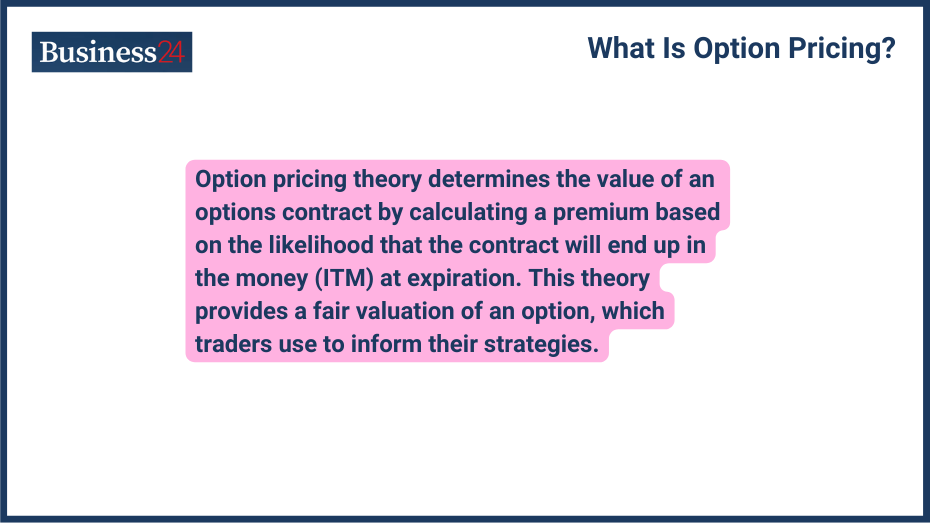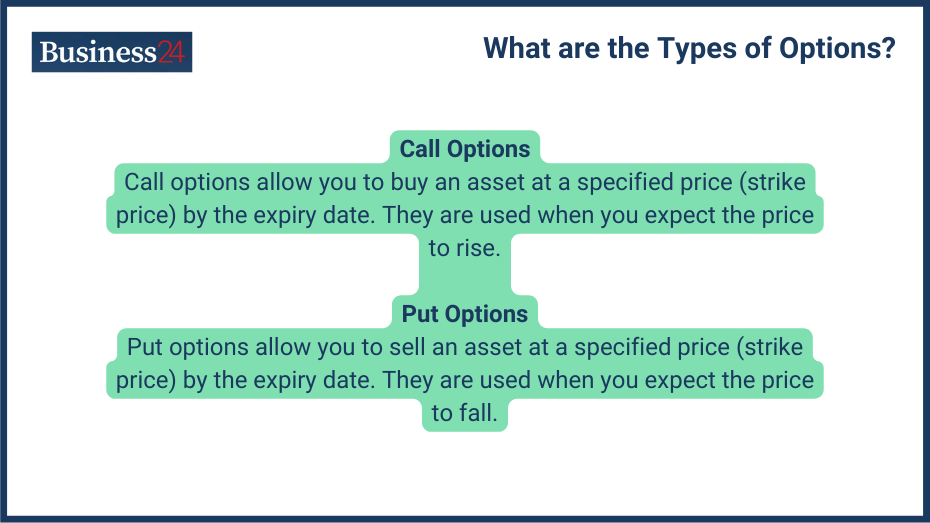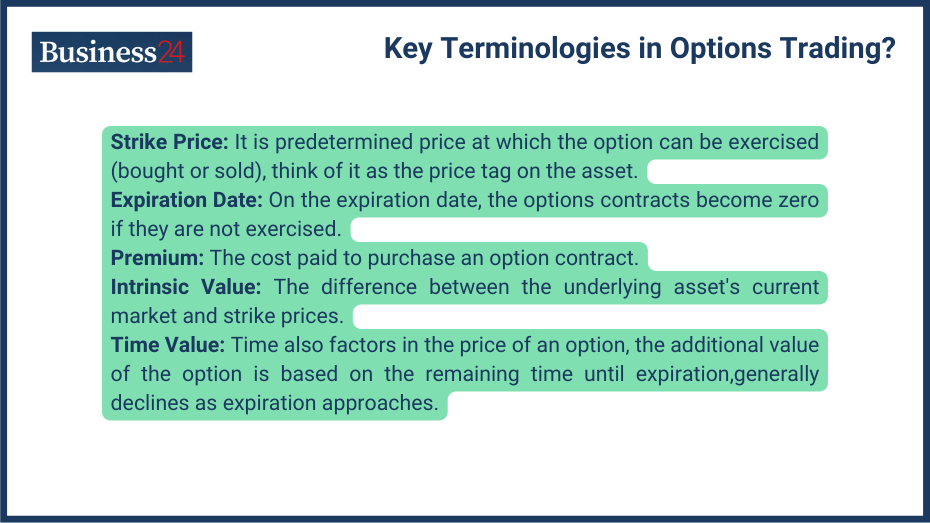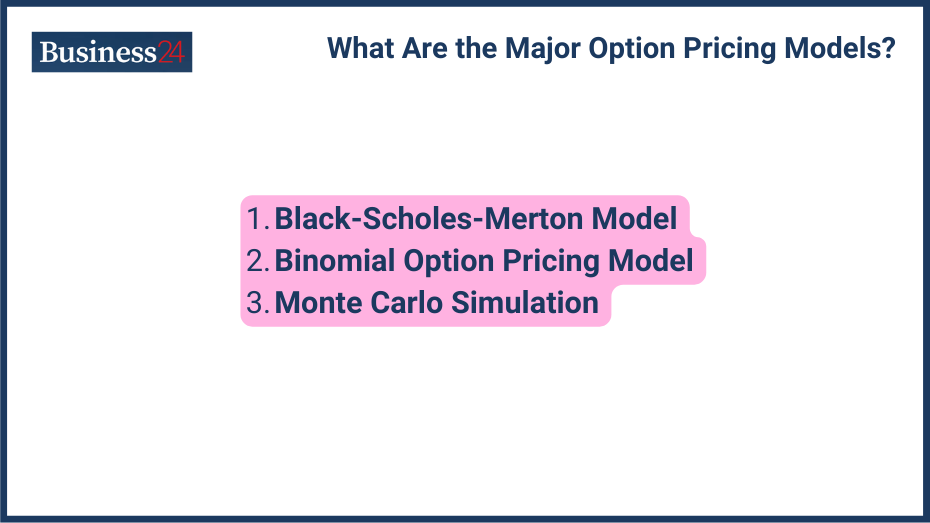
Option pricing theory determines the value of an options contract by calculating a premium based on the likelihood that the contract will end up in the money (ITM) at expiration. This theory provides a fair valuation of an option, which traders use to inform their strategies.
An options trader needs to know how options work because our minds adapt to them better when we see how things work. To understand how options work, you have to know how option pricing is done.
Option pricing determines the fair value or premium of an options contract. For this, you have to evaluate different things, like the underlying asset’s price, the strike price, time to expiration, volatility, interest rates, and dividends. These factors are like ingredients in a recipe, and the option pricing models are the formulas that use these ingredients to calculate the final value.
How is an option priced?
Option pricing is done using the option pricing theory. This theory provides the structure and mathematical models to estimate the fair value of an option. It will be a mistake if you value an option too highly; no one will buy it from you because they can find it at a lower price elsewhere. If you value an option too low, you’re selling it for cheap, losing out on potential profit.
Various models calculate option pricing based on factors like strike price, time to expiration, volatility, etc., and they help us avoid these extremes by estimating a fair price that considers various factors affecting the option’s value.
What Is Option Pricing Theory?
As I said, option pricing theory provides the framework and mathematical models used to calculate the fair value of options, but putting it more simply, the main work of option pricing theory is to estimate the price of an option while holding all else constant. It is built on two principles:
- Risk-Neutral Valuation: In this principle, we assume that investors are indifferent to risk as long as they earn the expected return. Or, if I put it in more simple words, investors only care about the expected return on their investment, not the level of risk involved. This simplifies calculations by eliminating the factor of individual risk tolerance.
- Arbitrage: taking advantage of price differences in different markets to make a profit without risk. However, market participants quickly eliminate arbitrage opportunities. Option pricing theory helps identify potential arbitrage situations, ensuring the option’s price reflects its true value.
We’ll talk about option pricing models later, but first, let’s understand the different types of options:
What Are the Types of Options?

So, for different conditions, there are two different types of options that traders can use in case the price moves in any direction:
Call Options
Let’s say I’m trading any asset and I predict the price to go up, so in that case i buy call options. A call option grants you the right, but not the obligation, to buy a specific asset at a predetermined price by a certain date.
By buying a call option, you select the purchase price today, and if the price goes up, you can exercise the option to buy at the lower strike price and sell at the higher market price, profiting from the difference.
Put Options
Just the opposite of the call options, you buy put options when you predict the price to go down. You have the right to execute the contract anytime you want before expiry.
By buying a put option, you secure the selling price today. If the price goes down, you can exercise the option to sell at the higher strike price, limiting your losses.
European vs. American Options
The only difference between European and American options is the time of execution of contracts. European options Can only be exercised on the expiration date. This means you must wait until the last day (expiry) to decide whether to buy or sell the underlying asset at the strike price. However, in American options, you can execute your contracts anytime before expiry.
What is standard option pricing?
Standard option pricing refers to the typical methods and models used to determine the fair value of standard options, such as plain vanilla calls and puts. These methods often rely on established models like Black-Scholes-Merton or binomial tree models, which incorporate the fundamental variables affecting option prices.
However, you’ll find that there is no single “standard” way to price options. But, well known and widely used option pricing models consider key variables like underlying asset price, strike price, time to expiration, volatility, risk-free interest rate, and dividends.
What is the concept of option pricing?
Option pricing revolves around the idea of fair value of the option contracts. It’s not what someone is willing to sell an option for or what you’re willing to pay, but rather the intrinsic value of the option itself based on its potential benefits. This fair value considers various factors that influence the option’s usefulness and risk profile.
Think of it like you are calculating the worth of a house to buy or sell; you consider factors like location, size, condition, and market trends to determine its worth. Similarly, option pricing models analyze factors that affect the option’s value, like the underlying asset’s price, time to expiration, volatility, etc.
What is the best option pricing?
The best practices in option pricing are using accurate models, considering all relevant variables, and continuously updating inputs to reflect current market conditions. The best models provide a balance between accuracy and computational efficiency, allowing traders and investors to make informed decisions.
What Are the Key Variables in Option Pricing?

Key Variables in Option Pricing:
- Underlying Asset Price: The current price of the stock, commodity, or other asset the option is based on. Movements of options depend upon the underlying asset price.
- Strike Price: The predetermined price at which you can buy (call) or sell (put) the underlying asset if you exercise the option. The closer the current asset price is to the strike price, the more valuable the option becomes.
- Time to Expiration (Time Decay): Time is a big factor in options and evaluation of remaining time until the option contract expires is very important. As the expiration date approaches, the option loses value due to time decay (theta). The time value is the primary reason options lose value even if the underlying asset price stays flat.
- Volatility: This measures how much is the price fluctuation of the underlying asset. Higher volatility generally leads to higher option prices because there’s a greater chance of the price moving in your favor and the option becoming profitable.
- Risk-Free Interest Rate: Risk-free interest, like govt bonds, affects the time value of the option. A higher risk-free rate reduces the option’s time value because the opportunity cost of holding the option increases.
- Dividends: If the underlying asset pays dividends, the price of options can be impacted. Since dividends reduce the value of the stock, they can also decrease or increase the value of an option.
What Are the Major Option Pricing Models?

There are three major option pricing models:
Black-Scholes-Merton Model
The Black-Scholes-Merton (BSM) model is the most famous and fundamental tool in option pricing due to its simplicity and analytical approach. It uses several factors, including the asset’s current price, the strike price, the time until the option expires, and a consistent risk-free interest rate.
But the drawback here is that it assumes that volatility and interest rates remain constant and do not account for dividends. This point is a notable limitation because dividends can affect the value of options.
The model offers formulas for calculating the fair value of both call and put options. One major issue is its treatment of volatility, as unchanging real market conditions show that volatility often varies, leading to differences between theoretical and actual option prices.
Binomial Option Pricing Model
The binomial model offers a more detailed method for valuing options than the continuous approach used by the Black-Scholes-Merton (BSM) model, for example, in a simple scenario where the price of an asset can either rise or fall over a short period, like a day until the option expires. This model calculates the option’s value at each potential future price and then works backward to determine today’s fair value.
For longer durations, the model uses a multi-period approach. This builds out a branching tree of possible price movements throughout the life of the option, offering a more precise valuation than the single-period version.
One of the key strengths of the binomial model is in pricing American options, which can be exercised at any point before they expire. The BSM model falls short here because it doesn’t account well for the effects of early exercise. Additionally, the binomial model can also manage scenarios with discrete dividends, adjusting the pricing tree to reflect the impact of these payouts.
Monte Carlo Simulation
Monte Carlo simulation uses random sampling to calculate the value of an option. This approach is quite adaptable and capable of dealing with complex options and situations that the Black-Scholes-Merton model or the binomial model can’t handle. It also allows for features like stochastic volatility, where volatility changes over time, or path-dependent options, which depend on the specific journey of the asset’s price.
However, this flexibility makes Monte Carlo simulations computationally demanding. When you’re dealing with complex options or a large number of simulations, it can really tax your system, and you might need specialized software to manage it.
What Are Option Greeks and Sensitivity Analysis?
Option Greeks are tools used to measure how sensitive an option’s price is to factors like volatility or the price of the asset it’s based on. Option Greeks are signs (Delta, Gamma, Vega, Theta, Rho) that quantify an option’s price sensitivity to various factors.
- Delta: Most important in all option greeks, this measures the rate of change in an option’s price relative to a change in the underlying asset’s price. For example, if the delta of a call option is 0.5, the option’s price is expected to increase by $0.50 for every $1 increase in the underlying asset’s price (assuming all other factors remain constant).
- Gamma: Gamma isn’t directly about the underlying asset’s price but how delta changes. It tells you how much the delta will increase or decrease as the underlying asset price moves. A high gamma indicates the delta is rapidly changing, suggesting the option’s price will become more or less sensitive to the underlying asset price movement as the price goes up or down.
- Vega: It measures how sensitive an option’s price is to changes in implied volatility. IV reflects the market’s expectation of how much the underlying asset’s price will fluctuate over the option’s lifetime. Generally, higher implied volatility leads to higher option prices, and vega reflects the magnitude of this change.
- Theta: Theta represents the time decay of an option’s price, one of the most important aspects of options. As time passes toward expiration, the option loses value due to this time decay, irrespective of the underlying asset’s price movement. Theta is typically negative for most options, and its magnitude increases as expiration approaches.
- Rho: Rho measures the sensitivity of an option’s price to changes in interest rates. The impact of interest rates on options can be complex, but generally, higher interest rates can lead to lower option prices, particularly for call options.
What Are the Practical Applications of Option Pricing?
- Hedging Strategies: One of the best uses of options is hedging. It is used by investors to control the loss in investments. A stock investor buys put options on the stock they own, if the stock price falls, the put option gains value, offsetting some of the losses in the stock portfolio, and option pricing can help how to make a hedging strategy.
- Speculative Strategies: Options offer the potential for leveraged profits by leveraging price movements. If your predictions are correct, options can increase gains, but they also come with the risk of magnified losses if the market moves against them.
- Portfolio Management: Options can enhance portfolio returns and manage risk. By incorporating options strategies, investors can create more customized risk-reward profiles for their portfolios.
What Are the Common Challenges in Option Pricing?
While option pricing models provide valuable insights, there are challenges to consider:
- Dealing with Implied Volatility: Calculating how much prices might change in the future is a continuous challenge in the market, and 100% accuracy is impossible. Implied volatility plays a big role in setting option prices and isn’t something you can directly see or measure. Investors and traders rely on market data and analysis to make educated guesses about future volatility.
- Estimating Accurate Inputs: Option pricing models use several key factors, such as the asset price, strike price, etc. The reliability of these factors directly influences how accurate the model’s predictions are. Investors should use trustworthy data sources and be mindful of possible errors in their estimates.
- Handling Exotic Options: Some options have complex features or conditions beyond the assumptions of standard pricing models. These “exotic options” can be challenging to price accurately. In such cases, advanced option pricing models or specialized software might be needed.
What Are the Case Studies and Real-World Examples?
- Historical Case Studies: Analyze past events where option pricing played a role. For instance, studying how options were used during major market crashes or periods of high volatility can provide valuable insights.
- Contemporary Examples: Review recent market events and how they impacted option prices. This could involve looking at how options on specific stocks behaved during earnings announcements or major news events.
- Analysis of Market Events: You can gain practical knowledge by knowing how specific events affect option pricing. You can analyze different events like changes in rates, GDP, etc.
What Are Some Educational Resources and Tools?
- Recommended Books and Articles: Opt for books or articles written by reputable financial experts or institutions. Look for content that explains option pricing models in detail, explores various options strategies, and delves into risk management techniques specifically for options trading. Check out this book.
- Online Courses and Tutorials: I don’t think there are many courses based only on option pricing, but they are included in many option learning courses. This course is good.
- Financial Calculators and Software Tools: Financial calculators designed for options trading can streamline option pricing calculations. They often incorporate built-in option pricing models and allow you to input various factors to see how they impact option prices. Hit and trial is a good method to understand option pricing.
Disclaimer
eToro is a multi-asset platform which offers both investing in stocks and cryptoassets, as well as trading CFDs.
Please note that CFDs are complex instruments and come with a high risk of losing money rapidly due to leverage. 51% of retail investor accounts lose money when trading CFDs with this provider. You should consider whether you understand how CFDs work, and whether you can afford to take the high risk of losing your money
This communication is intended for information and educational purposes only and should not be considered investment advice or investment recommendation. Past performance is not an indication of future results.
Copy Trading does not amount to investment advice. The value of your investments may go up or down. Your capital is at risk.
Don’t invest unless you’re prepared to lose all the money you invest. This is a high-risk investment and you should not expect to be protected if something goes wrong. Take 2 mins to learn more
eToro USA LLC does not offer CFDs and makes no representation and assumes no liability as to the accuracy or completeness of the content of this publication, which has been prepared by our partner utilizing publicly available non-entity specific information about eToro.
